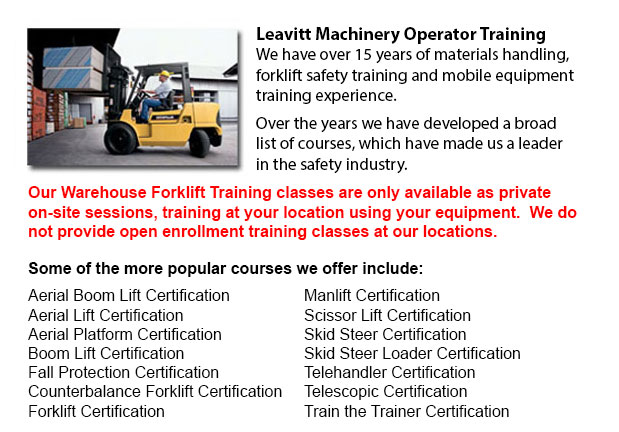
Warehouse Forklift Safety Training British Columbia - The corporation would face claims for liability when damage and injuries are sustained in an accident at the workplace. Warehouses can be a hazardous place to work for its workers, making employee safety a top priority for the company. Warehouse safety training is amongst the most effective measures to protect personnel, while minimizing costs connected with injuries and accidents.
Warehouses hold stock which could present various dangers, particularly related to materials handling. Moving stock, either by hand or making use of powered equipment, could cause injuries to workers' hands, fingers, toes and feet. Slipping, tripping and falling are common causes of injury. Heavy stuff can fall off shelves and harm workers. Forklifts and other machinery carry inherent hazards because they manipulate heavily laden pallets. Wrong lifting is a common source of back injuries. Even box cutters, nails and splinters could result in harm.
Warehouse conditions could change from one minute to the next, depending on the substances or materials being handling, the work being performed and the machine being used. Because of the wide variety of possible hazards in warehouse environment, warehouse operations are regulated by many different standards. There are regulations for storage and material handling, for walking and working surfaces, and rules governing the use and selection of PPE (personal protective equipment).
Most of the safety regulations covered by a company would consist of common sense regulations. Regulations that warehouse personnel must be quite familiar with consist of:
1. Safety is a top priority at all times while working in a warehouse.
2. PPE, like for example gloves, safety shoes, hard hats and eye protection, should be worn as appropriate.
3. Possible hazards should be inspected and reported.
4. Understand warning signals and signs - and follow them.
5. Pay attention to the job you are doing.
6. Pay attention to what others are performing nearby - especially forklifts and other dangerous machinery.
7. Make certain that stacked products and materials are stable and secured.
Adherence to good housekeeping rules would help to ensure a safe warehouse for all workers. Essential housekeeping regulations involve keeping floors and aisles clear of objects, such as wires and cords. Never perch objects insecurely on a surface. When spills occur, clean up at once. Throw trash in proper containers. Keep fire exits, fire extinguishers and sprinklers accessible. Put box cutters and other sharp tools away instantly after using. Report tripping hazards like for instance loose or damaged flooring.
-
Loader Operator Certification British Columbia
Loader Operator Certification British Columbia - Courses Offered For Getting Loader Operator Certification - Certification for forklifts are required to guarantee the safe operation of forklifts for those employers in industrial, warehouse or constru... More -
Crane / Overhead Crane / Self-Erect Crane / Truck Mounted Crane / Hydraulic Cranes Training in British Columbia
Bridge cranes or likewise called overhead cranes are actually a type of industrial material handling crane making use of a line and hook device that runs on a horizontal beam running along two widely separated rails. Numerous overhead cranes could be... More -
Scissor Lift License British Columbia
Scissor Lift License British Columbia - The operation of scissor lifts carries an inherent chance of danger. Whichever type of powered machine requires correct handling to prevent accidents causing injury or damage. Companies need to make certain tha... More -
Heavy Equipment Training Schools British Columbia
Heavy Equipment Training Schools British Columbia - There are a lot of heavy equipment training schools to select from. If you want to get to the best, it is important to check various aspects of the school in order to ascertain the level of educatio... More -
Telehandler Training British Columbia
Telehandler Training British Columbia - Telescopic handlers usually called telehandlers for short, are an extremely popular piece of heavy construction equipment. They are commonly utilized in the construction and agricultural trades. These machines... More -
Forklift Training Courses British Columbia
Forklift Training Courses British Columbia - When forklift operator safety training is tailored for illiteracy, training time is lessened by 50%. Forklift training certification, lift-truck operator driver safety training evaluation, and train the tr... More -
Heavy Equipment Operator Training British Columbia
Heavy Equipment Operator Training British Columbia - Heavy equipment operator training facilities which provide quality standards in the business, providing field performance work and added machinery training are highly sought after training features... More -
Heavy Equipment Operator Classes British Columbia
Heavy Equipment Operator Classes British Columbia - A person who has the right training in order to use a particular kind or piece of machinery is known as an equipment operator. There are various ways which an equipment operator could become trained... More

Forklift Training British Columbia
TOLL FREE: 1-888-254-6157
forklifttrainingbritishcolumbia.com
Email Us
About Us


